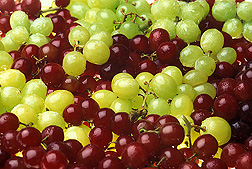This page has been archived and is being provided for reference purposes only. The page is no longer being updated, and therefore, links on the page may be invalid.
Read the magazine story to find out more. |
Automated System Predicts Grape Yields
By Jan SuszkiwApril 21, 2006
Estimating grape yields is a time-consuming, laborious affair. But that could change, thanks to a high-tech helping hand from Agricultural Research Service (ARS) scientists in Prosser, Wash.
There, ARS horticulturist Julie Tarara and colleagues have developed an automated system for estimating grape yields based on tension changes in the trellis wire used to support the vine crop. Her team is still field-testing the system. The hope is that the yield estimates it produces will allow growers and processors to better synchronize their pruning, watering, picking and juice-making operations.
According to Tarara, who works in ARS' Horticultural Crops Research Unit at Prosser, the current method of estimating grape yields involves counting berry clusters on sample vines, followed by counting and weighing of individual berries. The averages are then compared to records from past seasons to predict the current crop's likely yield.
Imprecise estimates can sometimes be costly. For example, an inflated yield estimate might lead a winery to order more barrels than it actually needs. The "pain" is in the price tag: New American oak barrels start at around $300, while new French oak barrels cost from $600 to around $800 each.
The scientists' automated system employs a device called a load cell to detect increases in the tension of trellis wire as grape clusters form and berries enlarge. A data logger records signals generated by the tension changes every 10 seconds, formulating an average every 15 minutes. Now, Tarara's team must download, inspect and "clean" data logger information for processing and eventual use in predicting grape yield. Once validated with field tests, though, the process will be completely automated, providing users with real-time information on their crop's progress, according to Tarara.
Her team's yield research complements a broader viticulture program at Prosser aimed at helping Pacific Northwest growers claim a greater share of domestic and world grape markets through improved farm practices and mechanized operations.
Read more about the research in the April 2006 issue of Agricultural Research magazine.
ARS is the U.S. Department of Agriculture's chief scientific research agency.

